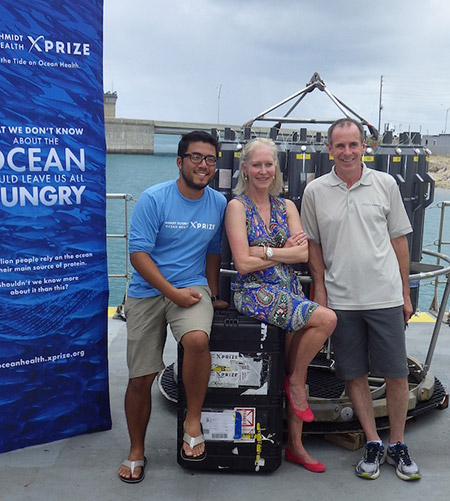
Team DuraFET Awarded $250,000 in Wendy Schmidt Ocean Health XPRIZE
Collaborative effort recognized for development of pH sensors for ocean acidification monitoring
Published Date
By:
- Rob Monroe
Share This:
Article Content

From left, Yui Takeshita of Scripps, Wendy Schmidt, and David Murphy of Sea-Bird Scientific
Team DuraFET, a collective of environmental and technology leaders from Honeywell Aerospace, Monterey Bay Aquarium Research Institute, Scripps Institution of Oceanography at UC San Diego, and Sea-Bird Scientific, has been awarded $250,000 in the Wendy Schmidt Ocean Health XPRIZE for its development of advanced deep-sea pH sensor technologies (SeaFET, SeapHOx and Deep-Sea DuraFET). The sensors allow scientists and oceanographers to accurately and easily observe ocean acidification, and address potential threats to global marine ecosystems.
This type of sensor technology is critical because rising levels of carbon in the atmosphere react in the ocean to create carbonic acid, resulting in increased ocean acidity. Ocean acidification can harm the ecological health of the world’s oceans and the industries that depend on that ecosystem.
Team DuraFET’s sensor technologies were the result of a seven-year partnership to develop, test, and successfully deploy a sensor that could provide precise pH measurements over year-long periods while remaining affordable and sustainable. The technology was based on Honeywell’s solid-state Ion Sensitive Field Effect Transistor, which enables a more accurate and cost-effective approach to ocean chemical sensing. Team DuraFET’s technology received a $250,000 prize in the Accuracy category that will be used to drive continued research into monitoring and balancing pH levels across varying ocean depths for months at a time. Team DuraFET will donate the prize money to the Argo ocean observing program. Argo is an international project dedicated to the observation of temperature and salinity of the earth’s oceans. This donation will enable Argo to begin broadening its mission to include ocean acidification.
“The addition of stable biogeochemical sensors for pH and other measurements is a valuable new dimension to the Argo program,” said Dean Roemmich, a professor of oceanography at Scripps and co-chair of the International Argo Steering Team. “Our current global core measurements have so far been only temperature, salinity, and ocean current. The addition of pH would give us a more comprehensive view of the ecological health of the global ocean.”
“Honeywell Aerospace has been a pioneer in safety and innovation technology for more than 100 years. And while that technology can normally be found flying 30,000 feet above the ocean, and not swimming beneath it, we understand how to create products that can withstand harsh environments,” said Robert Carlson, senior technical manager of Advanced Technology, Honeywell Aerospace. “As a part of Team DuraFET, we are able to use that expertise to better understand our oceans and to help keep them safe for generations to come.”
“The oceans are an essential natural resource whose resilience is being challenged by increasing acidity. What we don’t know is how bad the problem is because the health of regions away from the coast is almost completely unobserved right now due to the logistics and costs of operating research ships,” Kenneth Johnson, senior scientist, Monterey Bay Aquarium Research Institute. “The DuraFET pH sensor allows for the robotic observing of noncoastal regions, serving as a low-cost, easy-to-deploy sentinel for ocean health. Currently, a network of these remarkable sensors is being created by the Southern Ocean Carbon and Climate Observations and Modeling (SOCCOM) project program to observe the remote ecosystems of the Southern Ocean where susceptibility to acidification is greatest.”
“It has been exciting to play a role in adapting the DuraFET technology developed by Honeywell for use in the ocean,” said Todd Martz, associate professor, Scripps Institution of Oceanography. “This sensor would not exist without a strong partnership between leaders from both industry and academia, so it is a satisfying feeling to see a working technology come out of the long days and nights spent in the lab by scientists at Honeywell, the Monterey Bay Aquarium Research Institute, and a number of excellent graduate students at Scripps.”
“As the commercial partner on Team DuraFET, we are excited to be able to bring this technology from the laboratory to the ocean. By partnering with the strong institutions in Team DuraFET, we have developed a truly accurate and durable sensor that will significantly broaden our view on the health of our ocean ecosystem,” said Casey Moore, president, Sea-Bird Scientific. “Since the late 1970s, Sea-Bird has been trusted to provide the data that can solve the hardest real-world problems in the world’s oceans. We will use this experience to use Team DuraFET’s technology to create a broad family of products that will support essential acidification studies in the near-shore and ocean environments.”
Development of the oceanographic DuraFET sensors was supported by grants from the U.S. National Science Foundation, the National Ocean Partnership Program, and the David and Lucile Packard Foundation.
Share This:
You May Also Like
Stay in the Know
Keep up with all the latest from UC San Diego. Subscribe to the newsletter today.


